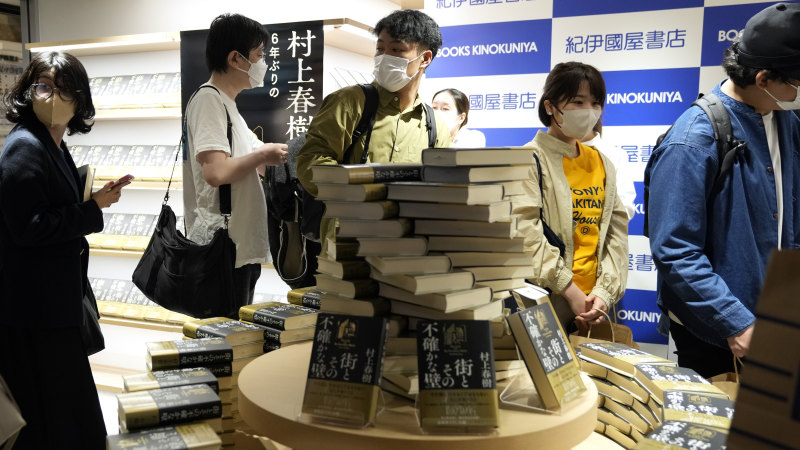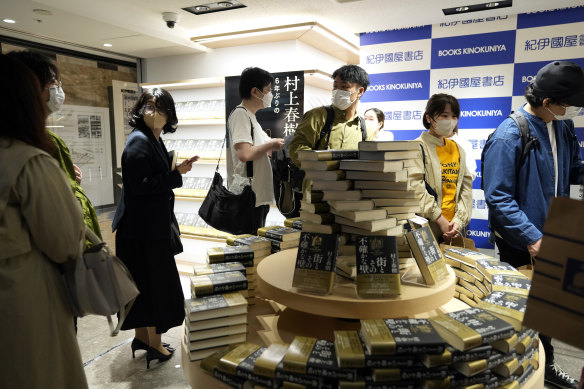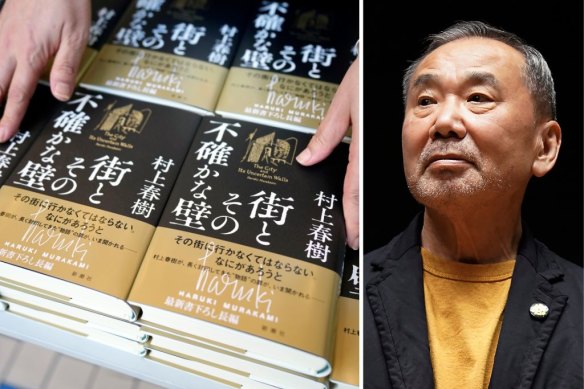Save articles for later
Add articles to your saved list and come back to them any time.
I’ve just come back from Japan, where a huge literary event was happening. People were queuing outside bookshops in a way we haven’t seen since the heady days of Harry Potter. What were they so eager to buy at the stroke of midnight? The first novel from Haruki Murakami in six years.
Sadly, my tour, which was excellent in other ways, didn’t take me to bookshops. The only queues I saw outside shops were high-end consumers waiting for their Rolex or Chanel fix. But even if I had bought The City and Its Uncertain Walls, I wouldn’t have been able to read it. The English translation won’t be available until later this year, but it’s bound to cause excitement. Murakami is one of the few writers who enjoys worldwide success both as a literary and as a popular author.
Customers line up to buy Haruki Murakami’s new novel The City and Its Uncertain Walls on the day of its release.Credit: Mari Yamaguchi
Meanwhile, Japanese fans are bingeing on the 661-page book, written by their beloved 74-year-old hero while he was in isolation during the pandemic. This latest novel is said to follow the narrator into a city with high walls, spanning his life from youth to middle age, with that trademark Murakami device of shifting between reality and a dreamlike state.
“I want to read it as soon as I get home. Although I’d like to savour every sentence, I’ll probably devour it in one sitting,” one of the first buyers told AFP.
Japan has a long and proud literary history. The book that is considered the world’s first novel, The Tale of Genji, was written by Murasaki Shikibu, a lady-in-waiting at the court of an emperor more than 1,000 years ago. There’s a statue of her outside Kyoto, and a new generation reads the story in a series of manga comics.
Our tour visited the magnificent golden Kinkaku-ji temple in Kyoto, which looks as old as the Japanese hills, but was actually reconstructed after the original was burned down in 1950 by a Buddhist acolyte. You can read his disturbing story in novel form in The Temple of the Golden Pavilion by Yukio Mishima, one of the greatest Japanese writers of the 20th century. He’s famous in the West for having performed seppuku, ritual suicide, but he should also be remembered for his books.
A shop clerk arranges copies of The City and Its Uncertain Walls by Haruki Murakami (right) on the first day for sale at Kinokuniya bookstore in Shinjuku.Credit: AP
Today, many Japanese are still keen readers. More than 23 per cent read books on a daily basis, about the same as in Australia. Add to this Murakami’s huge popularity, and that might explain why so many new talents have arisen to join the classics.
Where can we find their books in English? There are several useful online guides and too many authors to mention here, but if they have anything in common, it’s a tendency to write about the dark and the strange.
Among them are Banana Yoshimoto, who writes about youth, tragedy and food; Yoko Ogawa, whose science fiction novel The Memory Police is inspired by the diary of Anne Frank; Sayaka Murata, author of the quirky Convenience Store Woman; and mystery and fantasy writer Keigo Higashino. Only a few of their books are available in English, and I’d love to see more translations.
While I was in Japan I read an Australian novel, Cold Enough for Snow, Jessica Au’s exquisite little tale of a mother and daughter visiting Japan. Holiday tours are whirlwind voyages that don’t leave you much time for reflection, but Au’s narrator pauses often to summon memories and connections inspired by the vision of a flowing fabric or a beautiful ceramic bowl. Mother and daughter are Chinese in origin, but the Japanese spirit is everywhere in this poignant and enchanting meditation.
The Booklist is a weekly newsletter for book lovers from books editor Jason Steger. Get it delivered every Friday.
Most Viewed in Culture
From our partners
Source: Read Full Article


